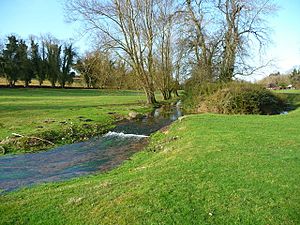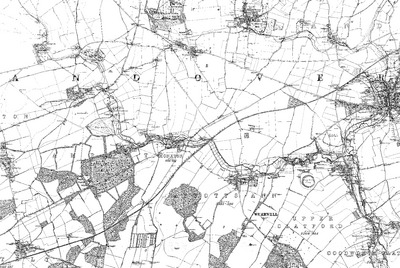Pillhill Brook facts for kids
The Pilhill Brook is a small river, about 9.9-kilometre-long (6.2 mi), located in Hampshire, England. It flows into the River Anton, which then joins the larger River Test. This brook is special because it's a 'chalk stream.' This means its water comes from underground chalk rocks, making it very clear and cool. Chalk streams are important habitats and are often known for good trout fishing.
Contents
What's in a Name?
Long ago, people might have called the Pilhill Brook by a different name: the Ann or Anna. For example, in old records from 1228, it was mentioned as aqua de Anne, which means 'water of Ann' in Latin.
Where the Brook Flows
The Pilhill Brook starts its journey near a village called Fyfield. From there, it flows past Thruxton. It then continues through an area known as Anna Valley, passing by the villages of Abbotts Ann, Little Ann, and Amport. Finally, the brook joins the River Anton near Upper Clatford.
Past Industries Along the Brook
The Pilhill Brook was once important for local industries.
Waterloo Ironworks
In 1813, two brothers, Robert and William Tasker, started a factory called the Waterloo Ironworks in the Anna Valley, near Upper Clatford. They used a waterwheel, powered by the brook's flowing water, to run their forge. A forge is a place where metal is heated and shaped. The Tasker brothers first focused on making equipment for farms. Later, from 1865, they began building large steam traction engines, which were like early tractors.
Watermills
Besides the ironworks, there were also four traditional watermills along the Pilhill Brook. These mills used the power of the water to grind grain into flour. They were located at Upper Mill in Monxton, Upper Mill in Abbots Ann, Abbots Ann Mill, and Sarsons Mill in Amport.
How Healthy is the Water?
The Environment Agency checks the water quality of rivers in England, including the Pilhill Brook. They give each river system an overall health rating. This rating can be high, good, moderate, poor, or bad.
Checking Water Quality
To decide the health rating, they look at a few things:
- Ecological Status: This checks the living things in the water. It looks at the types and numbers of tiny creatures (invertebrates), water plants, and fish.
- Chemical Status: This checks for harmful chemicals in the water. They compare the amount of chemicals found to safe levels. This status is either 'good' or 'fail'.
Pilhill Brook's Water Quality in 2019
In 2019, the Pilhill Brook had a 'good' ecological status, meaning the plants and animals living in it were doing well. However, its chemical status was a 'fail,' which means some chemicals were found above safe levels. Because of this, the overall health rating for the Pilhill Brook was 'moderate.'



